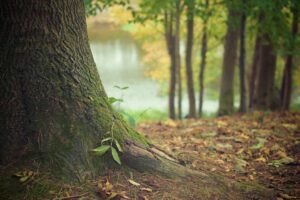Trees getting sick is unusual, but once they do, it can be a rocky road to learning the process of reviving the tree.
Usually, once foliage becomes established and grows to maturity, they have the vitality to stave off disease, avert problems with pests, and withstand extreme weather events.
Unfortunately, once there’s an open degree of vulnerability, a compromise to its health, these problems become significant risks making it critical that an arborist or gardener respond immediately. Click for guidance on when to remove a dead tree.
One of the first steps is recognizing the signs and symptoms to address the correct problem and institute adequate care for a full recovery. Reviving the tree from the grips of death is tough, but healing can begin once it is beyond that stage, and that is less challenging.
Let’s learn about verifying a tree is near death and how to help it gain enough strength to return.
How Can You Save A Tree That’s Near To Dying?

Before you can save a tree, verifying that death is imminent is essential. Once you can confirm, you need to find out what’s causing the distress. Sometimes a few basic guidelines will be sufficient to help the foliage gain strength to fend off the disease on its own then. Learn the signs if your tree is your dying.
In other instances, you’ll need to take action, which could include “replenishing the soil with macronutrients, incorporating pesticides, and in a scenario where you are at a loss for a solution, reach out to an expert arborist for professional assistance. Here are a few tips to consider.
● Consider the possibility of moisture issues
A fully grown, mature example is often quite secure whether the season is dry or particularly wet. A young treeling can struggle when the water is not almost at a perfect level, not over watered or under watered.
Usually, overwatering results due to weather conditions as opposed to human error. Drainage is likely inadequate with the soil surrounding the base. You can check the roots to see if they are soggy and soft, called “waterlogging.”
You will also notice a variety of molds and moss with minimal grass surrounding the base in the dirt. When there is constant water saturation around the bottom of the trunk, it’s an issue requiring a drainage solution or some way to provide sun’s rays to this area.
If it’s dry, the solution will be to introduce a sprinkler system or even fill up a bucket and serve the tree its drink routinely. Whatever is necessary to heal nature’s beauty.
● Is there too much mulch
Mulch is generally okay in moderation, but for some reason, people tend to establish a “bird’s nest” beneath the trunk using mulch. That alone creates a multitude of problems, including the following:
- Infestations of pests and fungi infections will thrive in that area.
- This part of the trunk will begin to decay.
- There is no way for the roots to access air to breathe.
If you’re guilty of developing this “cone,” go to the trees in your garden and thin these patches. If mulch has accumulated year after year, remove it every bit. Over Fertilizing can be as damaging as it will create “burns” considering the chemical compounds comprising the substances.
● Are you using adequate fertilizer
For most people, it’s a safe bet to simply purchase the “all-purpose” fertilizers and apply them in the same consistency as the mulch. While you might not see a reaction, in some cases, this can endanger the tree.
When your tree is showing signs of dying, the step to take is to test the soil to learn which macronutrients it’s lacking precisely, either potassium, nitrogen, or phosphorus.
In the same vein as mulch, fertilizer has the potential to attract nasty pests and bacteria to settle near the roots. When considering a tree’s roots, these are reminiscent of a mouth capable of being burned by fertilizer when coming in direct contact.
If sprinkling this close to the tree, it’s essential to be exceptionally light with the amount.
● The sick limbs should be trimmed
It will be challenging to know to what length the disease has spread, but you can trim what are noticeably diseased limbs from what looks like otherwise healthy foliage. You can prevent the illness from progressing by taking the opportunity to eliminate the “sick” spots, whether pieces of bark, limbs, or parts of the trunk.
A critical step after pruning is sterilizing the trimmers used on the diseased areas. Before the process, research the proper method for pruning the specific species. If you over-prune, it can send foliage into shock, which can be detrimental given its already weakened condition.
Final Thought
When you’ve established that the tree is dying and have tried the various remedies with little luck, it’s wise to enlist the help of an arborist or a professional tree company like Legacy Tree Company for assistance.
This is a professional tree doctor who can perform specific tests on different species, recognize those in distress, use preventive treatments and brace the foliage to add a degree of support, a solution when you thought there was none.




